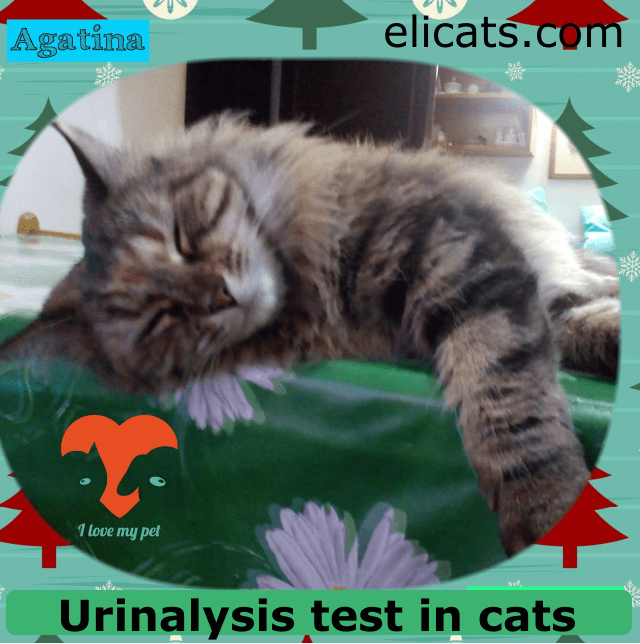A often underestimated test; urinalysis in cats, a useful test to diagnose: cystitides, calculi, polycystic kidney disease (PKD), acute or chronic renal failure.
Urinalysis test in cats
Why is it useful to perform urinalysis to our cat at regular intervals?
The examined sample allows to detect cystitides, bladder stones, lower urinary tract infections and inflammations, to diagnose kidney failure or cancer, and provides a useful result in the diagnosis of pancreatic pathologies such as diabetes or diseases which affect the liver.
How sample may be collected
From catheter: it involves inserting a tube into the urethra. It may require sedation
Cystocentesis: a needle is inserted through the abdominal wall to obtain an uncontaminated sample directly from the bladder
“Free” urine sample collected at home (will not be sterile)
Sample analysis
Color
The color should be light yellow amber; it must not be dark or orange colored, the presence of blood in the urine can color them red-brown, very concentrated urine may be dark yellow
Appearance
The urine must be clear; if it is cloudy there may be white blood cells (WBCs) also called leukocytes (infection)
Specific gravity
A very important parameter which allows to understand how well the kidneys are able to concentrate the urine.
Cats with healthy kidneys are able to produce concentrated urine around 1030-1050, on the contrary, if the urine is too diluted, this indicates a kidney disease or diabetes
GOOD TO KNOW
In diabetes mellitus (DM) (S.G. increases of 4 units every 10 g of glucose/lt)
In proteinuria also called albuminuria or urine albumin (S.G. increases of 3 units every 10 g of proteins/lt)
Urinalysis test in cats
Urine pH
Urine pH indicates if the urine is acidic or alkaline;
it indicates, for example, which type of calculi and crystals a cat may develop; the value 7 is considered neutral
Below 7 the urine is acidic, it should be remembered that acid urine helps to reduce struvite crystals formation and also favors its dissolution
Above 7 the urine is alkaline.
Microscopic examination and exam of the sediment
White blood cells (pyuria)
Their presence indicates an infection, kidney disease, diabetes.
Red blood cells (hematuria)
Even red blood cells do not have to be present in the urine, their presence suggests an inflammation, diseases, traumas, coagulation defects, calculi, cystitis or cancer
Glucose and ketones
Their presence is detected in diabetic cats, or in diabetic ketoacidosis
Bilirubin
Bilirubin is an orange bile pigment produced by the liver. It can indicate a liver disease, haemolysis (destruction of red blood cells), hepatic lipidosis or feline infectious peritonitis (FIP)
Proteins
Proteinuria should be evaluated together with urine specific gravity. In the presence of a high amount of proteins in the urine it might be useful to undertake a test called urinary protein electrophoresis
Urinary protein electrophoresis, is a test which allows to know, from quality point of view, which glomerular proteins are lost through urine.
On the basis of the origin of proteins, we can classify
- Pre-renal proteinuria
- Renal proteinuria
- Post-renal proteinuria
This technique can be performed on polyacrylamide gel, and takes the name of SDS-PAGE (sodium dodecil sulphate polyacrylamide gel electrophoresis) or on agarose gel, and takes the name of SDS-AGE (sodium dodecil sulphate agarose gel electrophoresis).
Urinalysis test in cats
URINE SEDIMENT AND URINE CULTURE
The urine sediment is an exam which separates the cells or other solid material (such as crystals) from the fluid part of the urine by centrifugation. The sediment is examined looking for red blood cells, white blood cells, bacteria, crystals, or other materials that must not be present in urine. In the presence of a urinary tract infection the veterinarian will also recommend the urine culture which establishes the specific type of bacteria and their sensitivity to a targeted antibiotic; the urine culture allows to prevent relapses, resolve the infection and avoid administering non-specific antibiotics to the cat.
THE CONTENT ON THIS WEBSITE IS TO BE USED FOR INFORMATIONAL PURPOSES ONLY. YOU ACKNOWLEDGE THAT THE CONTENT IS IN NO CASE TO BE USED AS A SUBSTITUTE FOR PROFESSIONAL MEDICAL ADVICE OR ADVICE FROM VETERINARIANS, NOR IS IT INTENDED TO BE RELIED UPON BY ANY PERSON OR ENTITY FOR PURPOSES OF MEDICAL DIAGNOSIS OR TREATMENT . IN NO CASE CAN BE USED AS A PRESCRIPTION OF A TREATMENT OR REPLACE A SPECIALIST EXAMINATION OR THE DIRECT RELATIONSHIP WITH YOUR VETERINARIAN/DOCTOR

